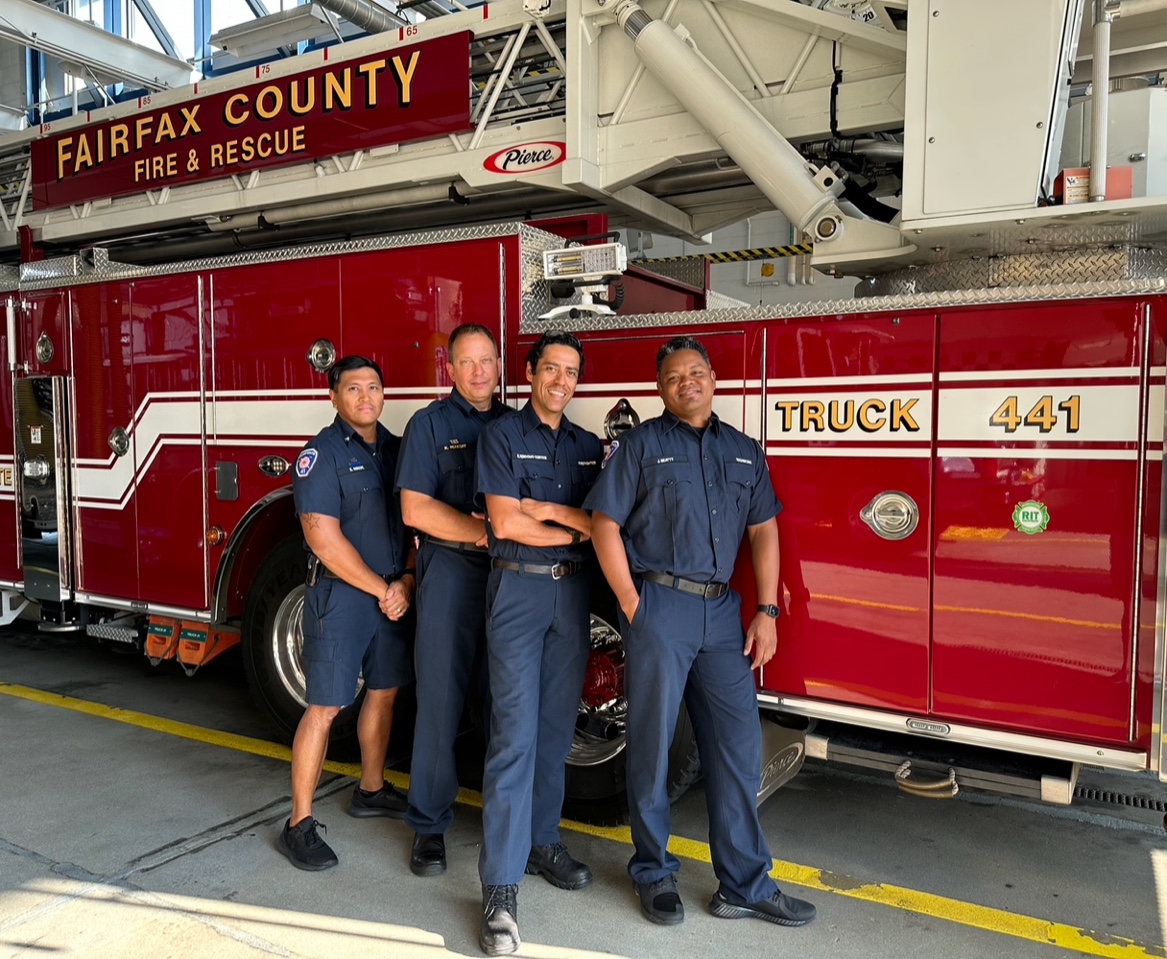Animal Protection Police were called to the former Nike site in Lorton last week for a large bird in trouble high in a tree. After assessing the bird’s position, Fairfax County Fire Department’’s Crosspoint Station 441, located close-by and with the ladder equipment needed to reach the stranded bird, was called in to assist.
Earlier on the morning of July 18 people in the area of a known Osprey platform nest observed an Osprey flying with a long train of material trailing behind it, making on-going distress calls. Other Ospreys were returning the calls. By early afternoon the next day a concerned resident observed the bird entangled in the branches of a tree in the perimeter of the Laurel Hill Golf Course, not far from the nest, Animal Protection Police were called to assist the bird. Responding, the officer determined that assistance from the Fire Department was needed to reach the top of the tree where the bird was entangled.
Firefighter R. Perdomo Cortes, a 17-year veteran of the fire department who has performed other bird rescues, was at the top of the ladder. He held the bird’s wings close to its body while the snagging tree branch was broken, then cut loose from the entangling materials. Was the fierce raptor intimidating? Cortes responded, “It was not too scary for me. She seemed to know she was getting help.” The bird was eased into a cardboard box to be carried down the ladder to the waiting Animal Protection Officer.
A decision was made on the ground to release the Osprey, identified as a female, to her calling family. It is unknown how long the bird had been entangled in the material alone, or the tree. Unfortunately, after she was released, the bird was not able to sustain flight. She was re-collected and taken to a local veterinarian for treatment.
 Fire Station 441 crew members Technician K. Gorospe, 19 years service; Lt. K. Reakoff, 13 years; Firefighter P. Cortes, 17 years; and Technician J. Beatly, 12 years; responded to the Osprey rescue with their ladder truck on July 19.
Fire Station 441 crew members Technician K. Gorospe, 19 years service; Lt. K. Reakoff, 13 years; Firefighter P. Cortes, 17 years; and Technician J. Beatly, 12 years; responded to the Osprey rescue with their ladder truck on July 19.
Ironically, the bird’s tree entanglement and later inability to fly away, may have saved her life after her talon was entangled. Osprey can die from entanglements through slow infection. Many entangled birds will not survive without human intervention. Liz Dennison of Secret Garden Birds and Bees, who has worked with birds of prey for over 14 years as a rehabilitator and educator, advises, “No bird that has been entangled should be released without first being seen by a rehabilitator or veterinarian familiar with the species. Many are able to fly away only to die later from their wounds or the stress of being entangled. Any bird that has been struggling with the line for days and ends up hanging from a tree is in need of medical care — no exceptions.” Dennison is grateful for everyone who works so hard to save the bird but says the Osprey should be given a medical check after trauma before being released.
Dennison adds, “Sadly this [bird entanglement] happens way too often - and not just to Ospreys.” She shares that most Osprey nests have fishing line, hooks, sinkers, and other debris in them. In addition to entanglements, rehabilitators see cases of lead poisoning from fishing tackle. Other birds in the Lorton area have needed rescue after entanglement in kite string left hanging in trees under tension.
Litter, a conspicuous problem nation-wide, is an issue for birds as well as other wildlife. In a Montana study area, polypropylene baling twine was found in 44.2% of Osprey nests annually between 2014 and 2022. The Lorton Osprey was entangled in a ball of orange and black construction materials.
The female Osprey (Pandion haliaetus) rescued in Lorton was a fledged juvenile, one of a brood of two raised by a pair of Osprey that has returned to nest on the same platform for multiple seasons. While not rare, Osprey pair nestings are still notable. This year and last year, the pair successfully raised two chicks.
The injured Osprey was initially taken to Pender Veterinary Centre in Fairfax, and then moved to Wildlife Rescue League in Falls Church for specialized care. Wildlife Rescue League is a non-profit 501 (c) (3) organization dedicated to providing care for sick, injured and orphaned wildlife with the intent of releasing them back into their native habitat.
A police spokesperson indicated the Osprey is expected to make a full recovery.
Ospreys tend to stay together once mated, returning to the same nest annually, adding to its size. Their diet is mostly live fish which they dive into the water to catch. They choose open nesting areas for an easy approach. With bright white heads, they are sometimes mistaken for Bald Eagles. A female osprey has a band of dark brownish streaks on her throat and around the neck and upper chest, sometimes referred to as a necklace. A male osprey has a white chest, uniformly pale underwing feathers, and a weaker or non-existent breast band. Eggs are laid in April, with chicks hatching in May or early June. Chicks fledge after 55 days, but will stay on the nest platform until migration in September.
Those seeking help for wildlife in distress can find several wildlife rescue and advice services in northern Virginia by searching online. Wildlife Veterinary Care offers a hotline providing advice for wildlife emergencies (504-664-9494). Wildlife emergencies often occur outside of hours when a veterinarian or rehabilitator can be reached. There is advice by species available at https://www.blueridgewildlifectr.org/wildlife-emergency. For for sick or injured wildlife contact Fairfax County Animal Protection Police at 703 691-2131, or for conflicts with wildlife, contact Virginia’s Department of Wildlife Resources at 855-571-9003.
